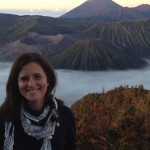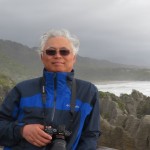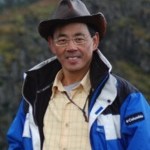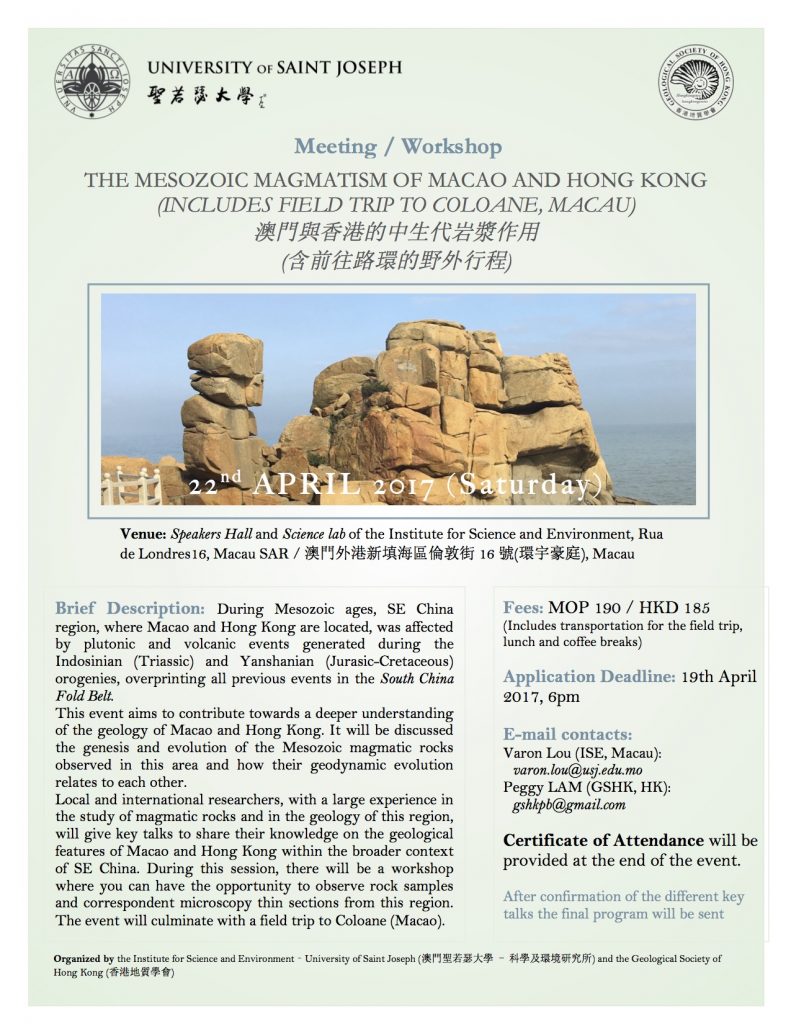MESOZOIC MAGMATISM OF MACAO AND HONG KONG
Mesozoic magmatism of Macao and Hong Kong in the context of SE China geodynamics
澳門與香港的中生代岩漿作用 (含前往路環的野外行程)
Date: 22nd April 2017 (Saturday) – Meeting and workshop + Field trip
Venue: Speakers Hall and Science lab of the Institute for Science and Environment, Rua de Londres16, Macau SAR | 澳門外港新填海區倫敦街16號(環宇豪庭), MacauOrganized by the Institute for Science and Environment – University of Saint Joseph (澳門聖若瑟大學 – 科學及環境研究所) and The Geological Society of Hong Kong (香港地質學會)
Organising Committee
Ágata Alveirinho Dias (Chair, ISE)
Paul Cheung (Co-Chair, GSHK)
Varon Lou (ISE):varon.lou@usj.edu.mo
Peggy Lam (GSHK):gshkpb@gmail.com
Pedro Quelhas (ISE)
Fees: MOP 190 / HKD 185 (Includes transportation for the field trip, lunch and coffee breaks)
Application Deadline: 20th April 2017, 6pm
E-mail contacts: Varon Lou (ISE, Macau): varon.lou@usj.edu.mo | Leung Wai Kin (GSHK, HK): gshkpb@gmail.com
Target participants: Earth science researchers, students, high school teachers, civil engineers and others interested in learning more about earth sciences and, in particular, to understand the geological history of Macau, Hong Kong and surrounding areas.
Language: English
NOTE: please plan to arrive at the workshop room 10 to 15 minutes before the workshop start time
Description:
During Mesozoic ages, SE China region, where Macao and Hong Kong are located, was affected by plutonic and volcanic events generated during the Indosinian (Triassic) and Yanshanian (Jurasic-Cretaceous) orogenies, overprinting all previous events in the South China Fold Belt.
This event aims to contribute towards a deeper understanding of the geology of Macao and Hong Kong. It will be discussed the genesis and evolution of the Mesozoic magmatic rocks observed in this area and how their geodynamic evolution relates to each other.
Local and international researchers, with a large experience in the study of magmatic rocks and in the geology of this region, will give key talks to share their knowledge on the geological features of Macao and Hong Kong within the broader context of SE China. During this session, there will be a workshop where you can have the opportunity to observe rock samples and correspondent microscopy thin sections from this region. The event will culminate with a field trip to Coloane (Macao).
PROGRAM
Morning Program:
9:30H | Opening session (ISE, USJ + GSHK): Ágata Dias and Paul Cheung USJ Speakers Hall |
10:00H | Talks |
12:00H | Observation/exhibition of rocks from Macau and Hong Kong |
13:00H | Meeting lunch |
Afternoon Program:
14:20H | Briefing for the field trip (Speakers hall) |
| 14:45H-18:00H | Field trip, lead by Pedro Quelhas |
| 18:30H | Arrival to USJ |
Certificate of Attendance will be provided at the end of the event.
SPEAKERS
9:30h - Opening talk (by Ágata Alveirinho Dias and Paul Cheung)

Ágata Alveirinho has a PhD in Geology and is Associate Professor at the Institute of Science and Environment USJ, in Macau. She is also a collaborating researcher at Instituto Dom Luis (Associate Lab) of the University of Lisbon, in Portugal. Since her graduation, followed by a MSc, a PhD and two postdoctorates, she has been working in Geology, publishing papers related with cartography, petrology, geochemistry and metallogeny. Along her research activities, she has been collaborating with different universities and research institutions around the world, such as IFREMER, Brest, France; ETH, Zurich, Switzerland; NOC, Southampton, UK; University of Bergen, Norway; FCUL, Lisbon, Portugal and GIGCAS, Guangzhou, China. She has been studying deep-sea hydrothermal processes and, more recently, she has been also developing work on the petrology and geochemistry of igneous rocks from Macau and SE China. She is currently the coordinator of a project funded by the Macao Science and Technology Development Fund, FDCT, to study the geological history of Macao and to update the geological map of this region.

Paul CHEUNG Chi Tak is the Chairman of the Professional Branch, Geological Society of Hong Kong and Vice President of the Geological Society of Hong Kong (GSHK). He serves as a Scrutineer for Chartered Geologist of the Geological Society of London and he was part-time lecturer in Engineering Geology with the Civil Engineering Department of Chu Hai College and in Soil Mechanics with the Civil Engineering Department of Hong Kong Polytechnic (High Certificate Course). In his early career, he worked for a British Consultants firm in Hong Kong as a graduate geologist/geotechnical engineer. Then worked as a mapping geologist with Mass Transit Railway for the site formation works on Kornhill Development. He then joined the then Geotechnical Control Office, Hong Kong Government in 1985 until retirement in 2015. Paul Cheung graduated with BSc in Geology with the National Taiwan University and MSc in geochemistry of gabbroic rocks with the University of Windsor, Canada. He also got a postgraduate Certificate in Business Administration with the Hong Kong City University. He carried out research on the Quaternary Marine Depositional Environment of Hong Kong with the Geography Department of the Chinese University.
10:00h - Reconstructing the architecture of the late Mesozoic Southeast China continental margin (by Rod Sewell)

Rod Sewell has been a member of the Hong Kong Geological Survey for over 27 years. Following completion of his PhD on an extinct volcano in New Zealand, he worked for the New Zealand Geological Survey studying volcanic geology and tectonics, with excursions to the Antarctic and USA. He has coauthored several books, papers, and maps on the geology of Hong Kong, New Zealand and Antarctica. Rod is Chief Training Geologist in the GEO/CEDD and is an Honorary Professor in the Department of Earth Sciences at the University of Hong Kong. He currently heads the Hong Kong Geological Survey, GEO/CEDD.
About the talk
A variety of tectonic models have been proposed for the origin of Jurassic (199-145 Ma) magmatism in SE China. These include both a mature continental arc setting and a within-plate setting. Among these models, subduction of the Palaeo-pacific plate along a convergent margin has the most support. However, not much is known about the structure of the convergent margin complex. Here, we use precisely-dated, well-studied, tectonostratigraphic terranes in Hong Kong, together with geochemistry and geochronology of granitic rocks, to help reconstruct the architecture of the Southeast China convergent margin in the late Middle Jurassic.
10:30h - Evolution of the late Mesozoic magmatic systems in Hong Kong: New perspectives from zircon geochronology and trace element analyses (by Denise Tang)

Denise graduated from the Department of Earth Sciences, HKU and joined the Geotechnical Engineering Office (GEO) as a graduate trainee in 1999. Since then, she has dedicated herself to the geology profession, and been working at the GEO for over 15 years. Denise co-authored the popular geology book “Hong Kong Geology – A 400-million year journey”, which has been one of the GEO’s best seller publications since its publication in 2009. Denise obtained her MPhil degree from the Department of Earth Sciences HKU in 2007, and has recently completed her PhD study at the Victoria University of Wellington, New Zealand.
About the talk
Spatial and temporal correlation of four late Mesozoic volcanic centres and their sub-volcanic plutons are well-constrained in Hong Kong. Of the four volcanic episodes, the youngest caldera-forming eruptions (of c. 140 million years ago) from the High Island Caldera have been interpreted to be of super-eruption scale. Multiple techniques including field studies, zircon SIMS geochronology and trace element analyses have been employed to gain new insights into the evolution of these ancient volcanic systems. The results show that in individual large volcanic systems, source composition and temperature may change over millions of years, and thereby generate two distinctly different groups of volcanic and granitic products. In this talk, some latest findings of Hong Kong’s magmatic history and their implications to our understanding of Yanshanian orogeny will be presented.
11:00h - Mesozoic magmatism in Macao: What is known so far and future developments (by Pedro Quelhas)

Pedro Quelhas graduated in geology from the Faculty of Sciences of the University of Lisbon (FCUL) and is currently a PhD student in the Institute of Science and Environment from USJ, where he is developing his research work on the petrology and geochemistry of Igneous Rocks from Macao: Implications for the Crustal Evolution of Southern China, funded by FDCT in Macau. His main interests are focused on igneous petrology, geochemistry and mineralogy. Before being enrolled in the PhD program he also did small research works on petrographic and geochemical features of the Lisbon Volcanic Complex and the dykes from Sines Massif, in Portugal. He was also lecturer at the Geology Department of FCUL.
About the talk
Although small in area (~30 Km2), our data shows that Macao territory has a wide range of granitic facies intruded by subordinate intermediate to acid dykes. Textural, mineralogical and geochemical variability of these rocks suggests different degrees of magmatic evolution in which fractional crystallization played a major role. Previous ages determined for Macao granites (Jurassic to Cretaceous) and their petrographic and geochemical features are similar to many granites occurring in neighboring areas, pointing to a genetic association with the Late Mesozoic magmatism related with the Yanshanian Orogeny. However, it is still not clear with the available data if these rocks were generated in the same magmatic event and/or derived from the same source. Isotopic data are now being acquired and precise dating of the different magmatic units will be undertaken soon, which will provide more answers for the local and regional magmatic history.
11:30h - Hydrothermal events in Hong Kong: constraints on timing and depth of occurrence (by Chan Lung)

Prof Chan Lung Sang is currently Principal of HKU SPACE Community College and HKU SPACE-Po Leung Kuk Stanley Ho Community College, as well as professor in Department of Earth Sciences at HKU. He received his bachelor degree from CUHK and his Masters and PhD in geology and geophysics from University of California-Berkeley. He taught geology at the University of Wisconsin for 10 years before he joined The University of Hong Kong in 1994. His research interests include the tectonics and geology of South China and applied geophysics. He has been actively promoting science education in Hong Kong. Currently he is a member of the Board of Directors of the HK Academy for Gifted Education and scientific advisor of HK Observatory. He chaired the Geological Society for the period 2001-2005 and was invited to be a guest host in several television documentaries on earth science subjects. In 2010, he was bestowed the first University Distinguished Teaching Award by The University of Hong Kong and the Best Original Research Award by HK Medical Journal in 2013.
About the talk
The Jurassic-Cretaceous magmatism in Hong Kong region was followed by multiple hydrothermal episodes during the Late Cretaceous through Cenozoic. The hydrothermal events resulted in deuteric mineralisation and silicification of sedimentary layers. A few hydrothermal episodes are found to postdate fold and thrust events as well as the Eocene Ping Chau formation. Authigenic aegirine and the cherty siltstone layer found in the lower member of Ping Chau formation are attributable to hydrothermal events with temperatures estimated at about 300oC. Stromatolitic structures are found to have been preserved in the silicified siltstone. In Double Island, folded sediments of the Pat Sin Leng formation were silicified within a, speculatively, breccia pipe. An examination of the hydraulic fractures in some quartz dikes on Lantau Island has enabled us to estimate the depth at which the fracturing occurred, based on thermodynamic consideration of the phase relation between water and gas as well as the geostatic gradient of the crust. The talk presents an overview of interesting hydrothermal features in Hong Kong and a discussion of their tectonic significance.

![]()
Mesozoic magmatism of Macao and Hong Kong in the context of SE China geodynamics
澳門與香港的中生代岩漿作用 (含前往路環的野外行程)
Date: 22nd April 2017 (Saturday) – Meeting and workshop + Field trip
Venue: Speakers Hall and Science lab of the Institute for Science and Environment, Rua de Londres16, Macau SAR | 澳門外港新填海區倫敦街16號(環宇豪庭), Macau
Organized by the Institute for Science and Environment – University of Saint Joseph (澳門聖若瑟大學 – 科學及環境研究所) and The Geological Society of Hong Kong (香港地質學會)
Organising Committee
Ágata Alveirinho Dias (Chair, ISE)
Paul Cheung (Co-Chair, GSHK)
Varon Lou (ISE):varon.lou@usj.edu.mo
Peggy Lam (GSHK):gshkpb@gmail.com
Pedro Quelhas (ISE)
Description:
During Mesozoic ages, SE China region, where Macao and Hong Kong are located, was affected by plutonic and volcanic events generated during the Indosinian (Triassic) and Yanshanian (Jurasic-Cretaceous) orogenies, overprinting all previous events in the South China Fold Belt.
This event aims to contribute towards a deeper understanding of the geology of Macao and Hong Kong. It will be discussed the genesis and evolution of the Mesozoic magmatic rocks observed in this area and how their geodynamic evolution relates to each other.
Local and international researchers, with a large experience in the study of magmatic rocks and in the geology of this region, will give key talks to share their knowledge on the geological features of Macao and Hong Kong within the broader context of SE China. During this session, there will be a workshop where you can have the opportunity to observe rock samples and correspondent microscopy thin sections from this region. The event will culminate with a field trip to Coloane (Macao).
Fees: MOP 190 / HKD 185 (Includes transportation for the field trip, lunch and coffee breaks)
Application Deadline: 2oth April 2017, 6pm
E-mail contacts: Varon Lou (ISE, Macau): varon.lou@usj.edu.mo | Leung Wai Kin (GSHK, HK): gshkpb@gmail.com
Target participants: Earth science researchers, students, high school teachers, civil engineers and others interested in learning more about earth sciences and, in particular, to understand the geological history of Macau, Hong Kong and surrounding areas.
Language: English
NOTE: please plan to arrive at the workshop room 10 to 15 minutes before the workshop start time
PROGRAM
Morning Program:
| 9:30H |
Opening session (ISE, USJ + GSHK): Ágata Dias and Paul Cheung USJ Speakers Hall |
|
10:00H |
Talks
|
|
12:00H |
Observation/exhibition of rocks from Macau and Hong Kong |
|
13:00H |
Meeting lunch
|
Afternoon Program:
|
14:20H |
Briefing for the field trip (Speakers hall)
|
|
14:45H-18:00H |
Field trip, lead by Pedro Quelhas and Ágata Dias Meeting point: In front of USJ (NAPE1 – Rua de Londres 16, Block B) |
| 18:30H | Arrival to USJ |
Certificate of Attendance will be provided at the end of the event.
SPEAKERS
9:30H – Opening talk (by Ágata Alveirinho Dias and Paul Cheung)
Ágata Alveirinho has a PhD in Geology and is Associate Professor at the Institute of Science and Environment USJ, in Macau. She is also a collaborating researcher at Instituto Dom Luis (Associate Lab) of the University of Lisbon, in Portugal. Since her graduation, followed by a MSc, a PhD and two postdoctorates, she has been working in Geology, publishing papers related with cartography, petrology, geochemistry and metallogeny. Along her research activities, she has been collaborating with different universities and research institutions around the world, such as IFREMER, Brest, France; ETH, Zurich, Switzerland; NOC, Southampton, UK; University of Bergen, Norway; FCUL, Lisbon, Portugal and GIGCAS, Guangzhou, China. She has been studying deep-sea hydrothermal processes and, more recently, she has been also developing work on the petrology and geochemistry of igneous rocks from Macau and SE China. She is currently the coordinator of a project funded by the Macao Science and Technology Development Fund, FDCT, to study the geological history of Macao and to update the geological map of this region.
Paul CHEUNG Chi Tak is the Chairman of the Professional Branch, Geological Society of Hong Kong and Vice President of the Geological Society of Hong Kong (GSHK). He serves as a Scrutineer for Chartered Geologist of the Geological Society of London and he was part-time lecturer in Engineering Geology with the Civil Engineering Department of Chu Hai College and in Soil Mechanics with the Civil Engineering Department of Hong Kong Polytechnic (High Certificate Course). In his early career, he worked for a British Consultants firm in Hong Kong as a graduate geologist/geotechnical engineer. Then worked as a mapping geologist with Mass Transit Railway for the site formation works on Kornhill Development. He then joined the then Geotechnical Control Office, Hong Kong Government in 1985 until retirement in 2015. Paul Cheung graduated with BSc in Geology with the National Taiwan University and MSc in geochemistry of gabbroic rocks with the University of Windsor, Canada. He also got a postgraduate Certificate in Business Administration with the Hong Kong City University. He carried out research on the Quaternary Marine Depositional Environment of Hong Kong with the Geography Department of the Chinese University.
10:00H – Reconstructing the architecture of the late Mesozoic Southeast China continental margin (by Rod Sewell)

Rod Sewell has been a member of the Hong Kong Geological Survey for over 27 years. Following completion of his PhD on an extinct volcano in New Zealand, he worked for the New Zealand Geological Survey studying volcanic geology and tectonics, with excursions to the Antarctic and USA. He has coauthored several books, papers, and maps on the geology of Hong Kong, New Zealand and Antarctica. Rod is Chief Training Geologist in the GEO/CEDD and is an Honorary Professor in the Department of Earth Sciences at the University of Hong Kong. He currently heads the Hong Kong Geological Survey, GEO/CEDD.
About the talk
A variety of tectonic models have been proposed for the origin of Jurassic (199-145 Ma) magmatism in SE China. These include both a mature continental arc setting and a within-plate setting. Among these models, subduction of the Palaeo-pacific plate along a convergent margin has the most support. However, not much is known about the structure of the convergent margin complex. Here, we use precisely-dated, well-studied, tectonostratigraphic terranes in Hong Kong, together with geochemistry and geochronology of granitic rocks, to help reconstruct the architecture of the Southeast China convergent margin in the late Middle Jurassic.
10:30H – Evolution of the late Mesozoic magmatic systems in Hong Kong: New perspectives from zircon geochronology and trace element analyses (by Denise Tang)

Denise graduated from the Department of Earth Sciences, HKU and joined the Geotechnical Engineering Office (GEO) as a graduate trainee in 1999. Since then, she has dedicated herself to the geology profession, and been working at the GEO for over 15 years. Denise co-authored the popular geology book “Hong Kong Geology – A 400-million year journey”, which has been one of the GEO’s best seller publications since its publication in 2009. Denise obtained her MPhil degree from the Department of Earth Sciences HKU in 2007, and has recently completed her PhD study at the Victoria University of Wellington, New Zealand.
About the talk
Spatial and temporal correlation of four late Mesozoic volcanic centres and their sub-volcanic plutons are well-constrained in Hong Kong. Of the four volcanic episodes, the youngest caldera-forming eruptions (of c. 140 million years ago) from the High Island Caldera have been interpreted to be of super-eruption scale. Multiple techniques including field studies, zircon SIMS geochronology and trace element analyses have been employed to gain new insights into the evolution of these ancient volcanic systems. The results show that in individual large volcanic systems, source composition and temperature may change over millions of years, and thereby generate two distinctly different groups of volcanic and granitic products. In this talk, some latest findings of Hong Kong’s magmatic history and their implications to our understanding of Yanshanian orogeny will be presented.
11:00H – Mesozoic magmatism in Macao: What is known so far and future developments (by Pedro Quelhas)
Pedro Quelhas graduated in geology from the Faculty of Sciences of the University of Lisbon (FCUL) and is currently a PhD student in the Institute of Science and Environment from USJ, where he is developing his research work on the petrology and geochemistry of Igneous Rocks from Macao: Implications for the Crustal Evolution of Southern China, funded by FDCT in Macau. His main interests are focused on igneous petrology, geochemistry and mineralogy. Before being enrolled in the PhD program he also did small research works on petrographic and geochemical features of the Lisbon Volcanic Complex and the dykes from Sines Massif, in Portugal. He was also lecturer at the Geology Department of FCUL.
About the talk
Although small in area (~30 Km2), our data shows that Macao territory has a wide range of granitic facies intruded by subordinate intermediate to acid dykes. Textural, mineralogical and geochemical variability of these rocks suggests different degrees of magmatic evolution in which fractional crystallization played a major role. Previous ages determined for Macao granites (Jurassic to Cretaceous) and their petrographic and geochemical features are similar to many granites occurring in neighboring areas, pointing to a genetic association with the Late Mesozoic magmatism related with the Yanshanian Orogeny. However, it is still not clear with the available data if these rocks were generated in the same magmatic event and/or derived from the same source. Isotopic data are now being acquired and precise dating of the different magmatic units will be undertaken soon, which will provide more answers for the local and regional magmatic history.
11:30H – Hydrothermal events in Hong Kong: constraints on timing and depth of occurrence (by Chan Lung)
Prof Chan Lung Sang is currently Principal of HKU SPACE Community College and HKU SPACE-Po Leung Kuk Stanley Ho Community College, as well as professor in Department of Earth Sciences at HKU. He received his bachelor degree from CUHK and his Masters and PhD in geology and geophysics from University of California-Berkeley. He taught geology at the University of Wisconsin for 10 years before he joined The University of Hong Kong in 1994. His research interests include the tectonics and geology of South China and applied geophysics. He has been actively promoting science education in Hong Kong. Currently he is a member of the Board of Directors of the HK Academy for Gifted Education and scientific advisor of HK Observatory. He chaired the Geological Society for the period 2001-2005 and was invited to be a guest host in several television documentaries on earth science subjects. In 2010, he was bestowed the first University Distinguished Teaching Award by The University of Hong Kong and the Best Original Research Award by HK Medical Journal in 2013.
About the talk
The Jurassic-Cretaceous magmatism in Hong Kong region was followed by multiple hydrothermal episodes during the Late Cretaceous through Cenozoic. The hydrothermal events resulted in deuteric mineralisation and silicification of sedimentary layers. A few hydrothermal episodes are found to postdate fold and thrust events as well as the Eocene Ping Chau formation. Authigenic aegirine and the cherty siltstone layer found in the lower member of Ping Chau formation are attributable to hydrothermal events with temperatures estimated at about 300oC. Stromatolitic structures are found to have been preserved in the silicified siltstone. In Double Island, folded sediments of the Pat Sin Leng formation were silicified within a, speculatively, breccia pipe. An examination of the hydraulic fractures in some quartz dikes on Lantau Island has enabled us to estimate the depth at which the fracturing occurred, based on thermodynamic consideration of the phase relation between water and gas as well as the geostatic gradient of the crust. The talk presents an overview of interesting hydrothermal features in Hong Kong and a discussion of their tectonic significance.
ISE Facebook page (Institute of Science and Environment/科學及環境研究所): HERE







